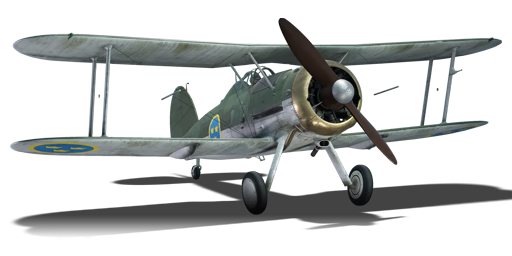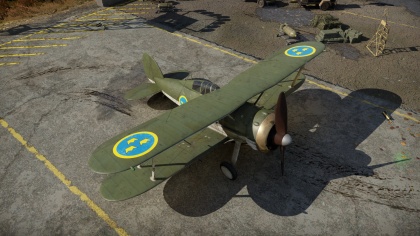J8A
Contents
Description
The J8A is a rank I Swedish fighter
with a battle rating of 1.0 (AB/RB/SB). It was introduced in Update 1.93 "Shark Attack" but is currently unavailable to be played in any game mode.
General info
Flight performance
Describe how the aircraft behaves in the air. Speed, manoeuvrability, acceleration and allowable loads - these are the most important characteristics of the vehicle.
| Characteristics | |||||||
|---|---|---|---|---|---|---|---|
| Stock | |||||||
| Max Speed (km/h at 4,420 m) |
Max altitude (meters) |
Turn time (seconds) |
Rate of climb (meters/second) |
Take-off run (meters) | |||
| AB | RB | AB | RB | AB | RB | ||
| 402 | 385 | 10211 | 16.7 | 17.3 | 13.4 | 13.4 | 232 |
| Upgraded | |||||||
| Max Speed (km/h at 4,420 m) |
Max altitude (meters) |
Turn time (seconds) |
Rate of climb (meters/second) |
Take-off run (meters) | |||
| AB | RB | AB | RB | AB | RB | ||
| ??? | 414 | 10211 | ??.? | 16.0 | ??.? | 15.7 | 232 |
Details
| Features | ||||
|---|---|---|---|---|
| Combat flaps | Take-off flaps | Landing flaps | Air brakes | Arrestor gear |
| X | ✓ | ✓ | X | X |
| Limits | ||||
|---|---|---|---|---|
| Wing-break speed (km/h) |
Gear limit (km/h) |
Combat flaps (km/h) |
Max Static G | |
| + | - | |||
| 520 | ~11 | ~5 | ||
| Optimal velocities | |||
|---|---|---|---|
| Ailerons (km/h) |
Rudder (km/h) |
Elevators (km/h) |
Radiator (km/h) |
| < 240 | < 200 | < 330 | > 190 |
| Compressor (RB/SB) | ||
|---|---|---|
| Setting 1 | ||
| Optimal altitude | 100% Engine power | WEP Engine power |
| 4,115 m | 810 hp | 826 hp |
Survivability and armour
The J8A does not have any armour.
Armaments
Offensive armament
The J8A is armed with:
- 2 x 8 mm Ksp m/22 machine guns, side-mounted (600 rpg = 1,200 total)
- 2 x 8 mm Ksp m/22 machine guns, wing-mounted (400 rpg = 800 total)
Usage in battles
Describe the tactics of playing in the aircraft, the features of using aircraft in a team and advice on tactics. Refrain from creating a "guide" - do not impose a single point of view, but instead, give the reader food for thought. Examine the most dangerous enemies and give recommendations on fighting them. If necessary, note the specifics of the game in different modes (AB, RB, SB).
Manual Engine Control
| MEC elements | ||||||
|---|---|---|---|---|---|---|
| Mixer | Pitch | Radiator | Supercharger | Turbocharger | ||
| Oil | Water | Type | ||||
| Controllable | Not controllable Not auto controlled |
Not controllable Not auto controlled |
Not controllable Not auto controlled |
Separate | Not controllable 1 gear |
Not controllable |
Modules
| Tier | Flight performance | Survivability | Weaponry | |
|---|---|---|---|---|
| I | Fuselage repair | Radiator | Offensive 8 mm | |
| II | Compressor | Airframe | ||
| III | Wings repair | Engine | New 8 mm MGs | |
| IV | Engine injection | Cover | ||
Pros and cons
Pros:
- Can go up to 418 km/h
- Its four 8mm machine guns can quickly shred other low tier planes
- Lots of ammo
- Very high max altitude for its rank
Cons:
- Climb rate is slower than most other planes that rivals it
- Higher than average required takeoff length
- No armour protection
History
Describe the history of the creation and combat usage of the aircraft in more detail than in the introduction. If the historical reference turns out to be too long, take it to a separate article, taking a link to the article about the vehicle and adding a block "/History" (example: https://wiki.warthunder.com/(Vehicle-name)/History) and add a link to it here using the main template. Be sure to reference text and sources by using <ref></ref>, as well as adding them at the end of the article with <references />. This section may also include the vehicle's dev blog entry (if applicable) and the in-game encyclopedia description (under === In-game description ===, also if applicable).
In 1936, a new defence resolution was made by the Swedish defence ministry to organise one new fighter wing and four new bomber wings in light of rising tensions in Europe. The new fighter wing was intended to provice aerial defence to the Stockholm region, and would consist of three squadrons. After a selection process, the Gloster Gladiator was found to be the aircraft most suited to requirements, and an order was made for 55 aircraft, which were to be locally fitted with engines and armament.
The first Gloster Gladiator was delivered to the Swedish Air Force on April 15th 1937 and locally designated as the 'Jaktplan 8' (J8). While the first few Swedish Gladiators were fitted with the Fairey three-bladed propeller, the decision was taken to switch back to the earlier fixed-pitch two-bladed wooden propeller. The first 37 aircraft were built to Gladiator Mk.I standard with a 645 hp NOHAB-built Bristol Mercury VIS2; the last batch of 18 aircraft were built to Gladiator Mk.II standard with a 840 hp NOHAB-built Bristol Mercury VIII. The former batch thus became known as the J8, while the latter batch was known as the J8A. Both types were armed with the Ksp m/36, which was a license-built version of the Browning M1917 chambered for 8x63mm ammunition. Deliveries of the Swedish Gloster Gladiator concluded on July 16th 1939, but two aircraft were already lost in service before deliveries were finalised. The Gladiators were initially allocated to F1 Västmanland in 1937 before a new wing was formed. This wing, F8, was transferred to Barkarby, north of Stockholm, in October of 1938, becoming F8 Barkarby.
Initial impressions of the Gloster Gladiator were mixed: the type was brand-new (having first flown in 1934 and having entered RAF service in February of 1937), but already conceptually outdated in comparison with types such as the German Bf 109, British Hawker Hurricane and the American P-35. As a result, more modern types were urgently sourced.
International events led to the Swedish J8 to have their combat debut in 1939 - albeit not under Swedish colours. Following the invasion of Finland by the Soviet Union on November 30th 1939, numerous countries offered military support to Finland, including neighbouring Sweden which went as far to form a volunteer squadron - Flygflottilj 19 - which would enter combat under Finnish colours. The F19 Wing consisted of 12 J8A Gloster Gladiators capable of carrying 8 light bombs and 4 B4 Hawker Harts light bombers, supported by a Junkers F13, a Raab-Katzenstein RB-26 and a Waco ZQC-6 liaision aircraft, and was manned entirely by Swedish volunteers. After intense negociations and preparations during December 1939 and early January 1940, the F19 Wing entered combat on January 12th 1940 with a raid on Soviet troop concentrations and air bases near Märkäjärvi, Salmijärvi and Salla. While the Hawker Hart bombers fared rather badly against enemy opposition (2 collided and 1 was shot down on this first raid, with 1 crew member killed, 2 taken PoW and 3 managing to ski back to their bases), the Gloster Gladiators went on to do rather better during their deployment. Over the course of two months, Swedish pilots claimed 10 kills; other than the 3 Harts lost on the first raid, the unit lost 3 Gladiators of which 2 were lost in accidents (one in a landing accident, pilot unhurt, and one due to structural failure, pilot killed), and 1 was shot down by Soviet airmen on January 23rd 1940 (pilot KiA). Following the cease-fire of March 13th 1940, the F19 Wing returned to Sweden and was disbanded.
In 1940, F8 Barkarby was re-equipped with the J9 (Seversky EP-1), with the J8s transferred to the F9 Säve wing which was tasked with protecting Gothenborg. The J8's stint with F9 was short, being replaced by the J11 (Fiat CR.42), after which they were used to equip the F10 Ängelholm Wing tasked with protecting Malmö. When the F10 Wing in turn was re-equipped with the J20 (Reggiane Re.2000), the J8's role as a frontline fighter in Swedish Air Force service was considered over, and the aircraft were distributed among other wings as advanced trainers, reserves and base hacks. During the latter part of their career in the Swedish Air Force, J8s were used piecemeal by the F8, F9, F10, F13, F16 and F20 wings. About 20 aircraft remained in service at the end of the Second World War, at which point they were progressively withdrawn from service as they were considered as being at the end of their service life. The last three Swedish J8 Gladiators were withdrawn from service on February 10th 1947.
Media
Excellent additions to the article would be video guides, screenshots from the game, and photos.
See also
Links to the articles on the War Thunder Wiki that you think will be useful for the reader, for example:
- reference to the series of the aircraft;
- links to approximate analogues of other nations and research trees.
External links
Paste links to sources and external resources, such as:
- topic on the official game forum;
- encyclopedia page on the aircraft;
- other literature.
| Sweden fighters | |
|---|---|
| ASJA | J6B |
| Saab | J21A-1 · J21A-2 · A21A-3 |
| FFVS | J22-A · J22-B |
| Foreign Import | J8A · Iacobi's J8A · J9 Early · J11 · J20 · J26 David · J26 |
| Finland | |
| VL | Mörkö-Morane · VL Myrsky II · VL Pyörremyrsky |
| (NL) Fokker | ▄Fokker D.XXI-3 · ▄Fokker D.XXI |
| (DE) Messerschmitt | ▄Bf 109 G-2 · ▄Bf 109 G-6 Erla · ▄Bf 109 G-6 |
| Other | ▄B-239 · ▄Hurricane Mk I/L |





